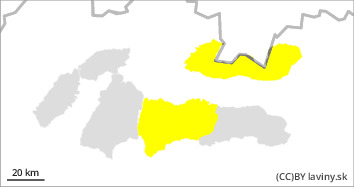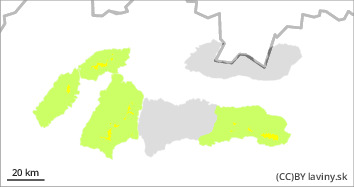
Danger level
 | 1600m |
|  |
|  | ||||
|  |  |

Avoid steep places with wind-drifted snow on the leeward sides.
In the High, Western and Low Tatras there is a MODERATE avalanche danger, 2nd degree. Newly wind-drifted snow above the forest zone shows instability, so avoid steep places, especially on leeward slopes. Small to medium sized slab avalanches are possible, especially with higher additional loads. Occasional spontaneous avalanches are also possible.
Snowpack
The snow cover is mostly new snow. Depending on the wind, its height varies from 5 to 25 cm, even half a metre in leeward places, under saddles, ridges and rock walls. Under the new snow, at altitudes up to 2000 m above sea level, there is a layer of snow crust from the previous warming and rain. A critical layer of faceted snow is beginning to form at their interface due to the cold temperatures, which will be a problem in the coming days.
Tendency
The tendency will be slightly increasing due to the emerging faceted snow.



